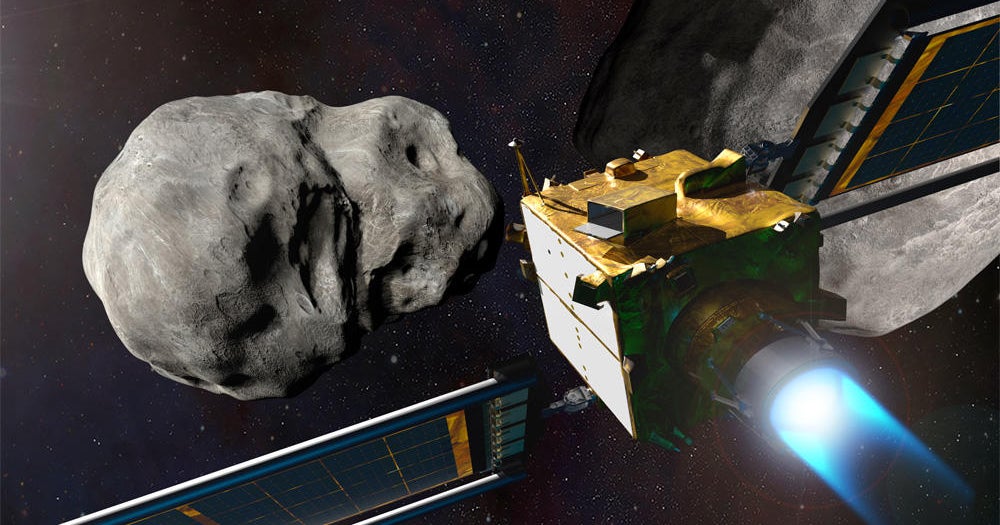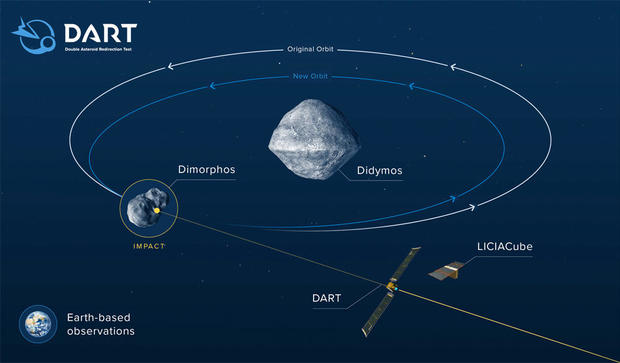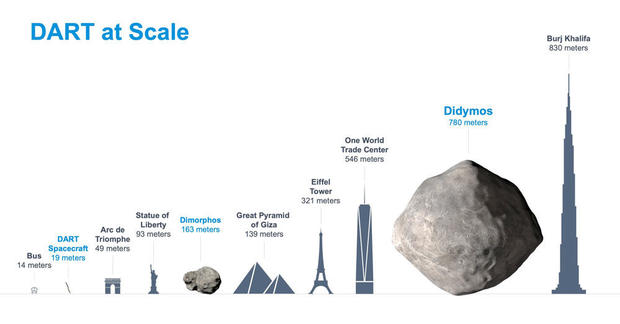Seven million miles from Earth, a NASA spacecraft slammed into a tiny asteroid at a staggering 14,000 miles per hour on Monday, the first real-world test of humanity’s ability to nudge a menacing body off course before it can hit Earth.
The asteroid in question, the 525-foot-wide body known as Dimorphos, is actually a moon orbiting the 2,500-foot-wide asteroid Didymos. Neither poses any threat to Earth either before or after NASA’s 1,260-pound Dual Asteroid Redirect, or DART, spacecraft strike.
But the twin-asteroid system was an ideal target for the $330 million DART mission because the effects of the probe’s impact can be measured from Earth by pinpointing how the collision changes the moon’s orbital period around Didymos.
Sending images of Dimorphos once a second, the DART probe gave scientists a spectacular view from the side as the spacecraft locked on and raced toward its quarry, first sighted about an hour before impact when the target was still 15,000 miles away.
NASA
After covering the last 1,000 miles in about four minutes, the DART camera showed the target growing larger and larger, from a dim point of light until it filled the entire field of vision seconds before impact, moving seven times faster than an automatic bullet.
– My God, look at this! shouted someone in the control room seconds before the impact, when stones and boulders rushed to the surface of Dimorphos.
“This is awesome guys! Oh my god, look at that! Unbelievable!” said Elena Adams, a DART mission systems engineer at Johns Hopkins University’s Applied Physics Laboratory who helped monitor the spacecraft’s final moments.
Transmissions stopped at the moment of impact as the spacecraft slammed into Dimorphos, collapsing on impact and exploding a new crater on the rocky surface. Because the collision happened 7 million miles from Earth, the last few images took 45 seconds or so to cross the gulf and get into NASA’s computers and live feed.
NASA
And at that moment, after years of planning and a 10-month journey from Earth to the Didymos-Dimorphos system, flight controllers at APL, where the DART spacecraft operated, erupted in cheers and applause.
“Congratulations! Boy, the DART team, you really did a great job,” said NASA Administrator Bill Nelson. “I believe it will teach us how to one day protect our own planet from an approaching asteroid. So thank you to this international team. We show that protecting the planet is a global undertaking and saving our planet is very possible. “
Lori Glaze, director of NASA’s Planetary Sciences Division, agreed, saying the DART mission shows that “we’re entering a new era for humanity, an era where we can potentially protect ourselves from something like a dangerous asteroid impact.”
NASA
“What a strange thing!” she said. “We’ve never had this opportunity before.”
A small Italian spacecraft known as LICIACube, launched by DART earlier this month, attempted to photograph the collision and the debris that flew back into space, but those images were saved on board and will be beamed back to Earth later.
A virtual telescope project that offers time on robotic telescopes to both professional astronomers and amateurs has been published by views of the binary asteroid during the collision which showed sharp lighting from the supposed clouds of rocks and dust blown into space around Dimorphos.
“Planetary defense is a global, unifying effort that affects everyone on Earth,” NASA Science Chief Thomas Zurbuchen said in a statement. “We now know we can target a spacecraft with the precision needed to impact even a small body in space. Just a small change in its speed is all we need to make a significant difference in the path of the asteroid.”
The Didymos-Dimorphos binary asteroid system was an ideal site for testing planetary defenses because the rover’s orbit passes directly in front of and then behind Didymos as seen from Earth, allowing scientists on Earth to precisely measure subtle changes in the combined light reflected from both asteroids. .
NASA
By measuring how the light dims and brightens, the researchers calculated how long it would take Dimorphos to complete one orbit – 11 hours and 55 minutes – and post-impact observations will allow them to determine what effect DART may have had.
Researchers expect the crash to shorten the asteroid’s orbital period by about 10 minutes, but it will take days to weeks for telescopes around the world and in space, including the Hubble and James Webb Space Observatories, to make the measurements needed to tally the numbers.
“The Double Asteroid Redirection Test is a test,” said Tom Statler, DART program scientist. “We do this test when we don’t need to, on a non-hazardous asteroid, in case we ever need to and we find a hazardous asteroid.”
He said the DART mission has two main goals, the first of which is to test “our ability to build an autonomously piloted spacecraft that will actually achieve a kinetic impact on an asteroid.”
NASA
“The second is a test of how a real asteroid would react to a kinetic impact,” he said. “Because at the end of the day, the real question is how effectively did we move the asteroid, and can this kinetic impact technique be used in the future if we ever need it?”
Unlike Hollywood thrillers like “Armageddon” and “Deep Strike,” which featured manned flights carrying nuclear bombs to deflect or destroy targets, DART’s targeting is much simpler and less destructive.
While nuclear weapons may be the last resort in a future Armageddon-class scenario, deflection, not destruction, will still be the goal.
“You just don’t want to blow it up because it’s not going to change the direction of all the stuff,” Lindley Johnson, NASA’s planetary defense officer, told CBS News before DART’s launch last November. “It’s still coming at you, it’s just a fraction, not a ball.”
“What you want to do is just change the speed at which it all moves a little bit. Over time, this will change the position of the asteroid and its orbit.”
https://www.cbsnews.com/news/nasa-dart-probe-attempts-alter-asteroid-trajectory-dimorphos-didymos-planetary-defense-test/









